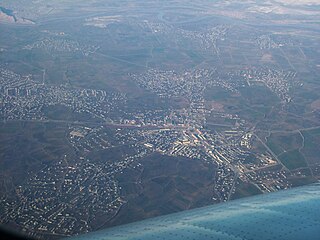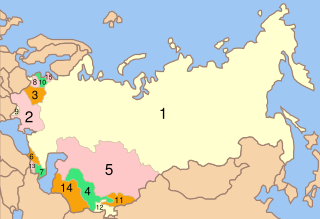
Demographic features of the population of Uzbekistan include population growth, population density, ethnicity, education level, health, economic status, religious affiliations, and other aspects of the population. The nationality of a person from Uzbekistan is Uzbekistani, while the ethnic Uzbek majority call themselves Uzbeks. Much of the data is estimated because the last census was carried out in Soviet times in 1989.

Kumyks are a Turkic people, living in Dagestan, Chechnya and North Ossetia. They are the largest Turkic people in the North Caucasus.

Serbian diaspora refers to Serbian emigrant communities in the diaspora. The existence of a numerous diaspora of Serbian nationals is mainly a consequence of either economic or political reasons.

The history of the Jews in Armenia is one of the Jewish communities in the Caucasus region. There is evidence of Jewish settlement in the Armenian Highlands dating as early 1st century BC.

The Lom people, also known by non-Loms as Bosha or Posha or as Armenian Romani or Caucasian Romani, are an ethnic group originating from the Indian subcontinent. Their Lomavren language is a mixed language, combining an Indo-Aryan substrate with Armenian.

Sharur is a city in the Nakhchivan Autonomous Republic of Azerbaijan. It is the administrative centre of the Sharur District. The city is located 66 km northwest of Nakhchivan city, on the Sharur plain.

The Black Sea Governorate was a province (guberniya) of the Caucasus Viceroyalty of the Russian Empire, established in 1896 on the territory of the Black Sea Okrug of the Kuban Oblast. The administrative center of the governorate was the Black Sea port of Novorossiysk. In 1905, the population of the governorate was approximately 70,000 and its area was 6,455 square versts, making it the smallest Russian governorate by both measures. The governorate ceased to exist when the Black Sea Soviet Republic was established on its territory in the spring of 1918—later the governorate was incorporated into the Kuban-Black Sea Oblast of the Russian SFSR in March 1920.

Preobrazheniye is an urban locality in Lazovsky District of Primorsky Krai, Russia, located on the Preobrazheniye Bay of the Sea of Japan. Population: 7,184 (2010 Census); 9,335 (2002 Census); 12,213 (1989 Census).

The Dagestan Oblast was a province (oblast) of the Caucasus Viceroyalty of the Russian Empire. It roughly corresponded to most of present-day southeastern Dagestan within the Russian Federation. The Dagestan oblast was created in 1860 out of the territories of the former Caucasian Imamate, bordering the Terek Oblast to the north, the Tiflis Governorate and Zakatal Okrug to the west, the Elizavetpol Governorate to the south, and Baku Governorate to the east. The administrative center of the oblast was Temir-Khan-Shura.

The Kutaisi or Kutais Governorate was a province (guberniya) of the Caucasus Viceroyalty of the Russian Empire. It roughly corresponded to most of western Georgia throughout most of its existence, and most of the Artvin Province of Turkey between 1878 and 1903. Created out of part of the former Georgia-Imeretia Governorate in 1846, the governorate also included Akhaltsikhe uezd before its cession to the Tiflis Governorate in 1867. The Kutaisi Governorate bordered the Sukhumi Okrug to the northwest, the Kuban Oblast to the north, the Terek Oblast to the northeast, the Tiflis Governorate to the southeast, the Batum Oblast to the southwest, and the Black Sea to the west. The governorate was eponymously named for its administrative center, Kutais.

The Terek Oblast was a province (oblast) of the Caucasus Viceroyalty of the Russian Empire, roughly corresponding to the central part of Russia's North Caucasian Federal District. Тhe оblast was created out of the former territories of the North Caucasian Peoples, following their conquests by Russia throughout the 19th century. The Terek Oblast bordered the Astrakhan and Stavropol governorates to the north, the Kuban Oblast to the west, the Kutaisi and Tiflis governorates to the south, and the Dagestan Oblast to the east. The administrative center of the oblast was Vladikavkaz, the current capital of North Ossetia–Alania within Russia.
Russians in Uzbekistan comprised the country's second-largest ethnic group after Uzbeks, numbering 1,653,478, in 1989 representing 5.5% of the population. During the Soviet period, Russians constituted more than half the population of the capital city, Tashkent. Uzbekistan counted nearly 1.5 million Russians, 12.5% of the population, in the 1970 census.

The 1959 Soviet census conducted in January 1959 was the first post-World War II census held in the Soviet Union.

The Soviet census conducted in January 1970 was the first census held in Soviet Union (USSR) in eleven years.

In January 1979, the Soviet Union conducted its first census in nine years. Between 1970 and 1979, the total Soviet population increased from 241,720,134 to 262,084,654, an increase of 8.4%.
The census in Azerbaijan is a process of collecting, summarizing, analyzing and publishing the demographic, economic and social data of the population living in the territory of Azerbaijan. The next census in the Republic is expected to be held in 2019.

The Geokchay uezd was a county (uezd) of the Baku Governorate of the Russian Empire and then of the Azerbaijan Democratic Republic and Azerbaijan SSR until its formal abolishment in 1929. The uezd was located in the central part of the governorate, bordering the Kuba uezd to the north, the Shemakha uezd to the east, the Javad uezd to the south and the Elizavetpol Governorate to the west. The administrative center of the uezd was the city of Geokchay.
Between 1929 and 1995, Armenia's administrative subdivisions consisted of up to 37 raions and 22 cities. Originally formed from the territory of the tsarist uezds (counties) between 24 June 1929 and 1930, the districts of the Armenian Soviet Socialist Republic and later the independent Republic of Armenia were combined on 11 April 1995 into ten provinces known as marzes, in addition to Yerevan which, being the capital of the country, was granted a special administrative status. Prior to the establishment of the raions, Soviet Armenia consisted of nine uezds, three of which were formed after the Sovietization of Armenia and the 1921 delineation of the South Caucasian republics' frontiers.

The Noyemberyan District was a raion (district) of the Armenian Soviet Socialist Republic from 1937 to 1991 and of the Republic of Armenia from 1991 to 1995. It now constitutes the northeastern part of the Tavush Province (marz) of Armenia. Its administrative center was the town of the same name.
















